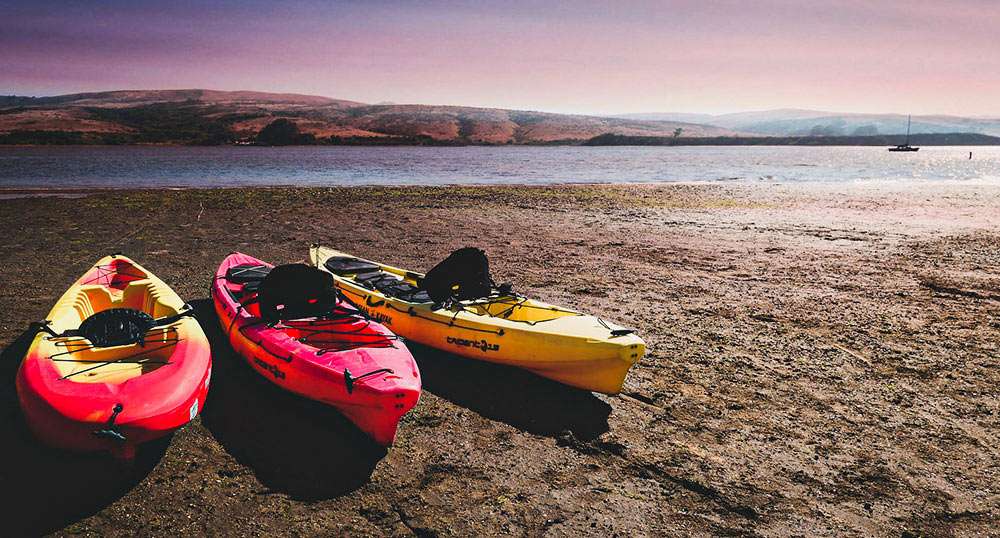Love them or hate them, you simply can’t afford to ignore paddle floats. Paddle floats have come an integral part of kayaking and without them you will find it very hard to do a self-rescue in case your boat gets capsized in the middle of nowhere. Paddle boats makes it super easy to make a reentry into the boat if it gets upturned somehow. Majority of the paddle floats are made from foam like material and thus making them ideal for cold weather condition. Without paddle floats, you will have a hard time getting into the cockpit if your kayak somehow gets swamped. This is the reason why it is essential for all kayakers to have a proper understanding of paddle floats.
Best 5 Kayak Paddle Floats
the water, this float’s got you covered. And hey, safety first, always! Keep paddling, my friends
01. Wisemen Trading Paddle Float
The Wisemen Trading Paddle Float is a practical safety tool for solo paddlers who want extra confidence while kayaking in open or unpredictable waters. Designed with dual air chambers and quick-inflate valves, this paddle float attaches to your paddle blade to create an outrigger-like stabilizer—helping you re-enter your kayak after a capsize. It’s compact, easy to store, and made from tough, water-resistant materials that stand up to regular use.
While essential for self-rescue, this paddle float doesn’t fit every paddle shape perfectly and may take some adjusting during setup. Also, it lacks a built-in reflective strip or bright coloring, which would be useful in low-visibility situations. Still, as a budget-friendly piece of kayak safety gear, it offers good peace of mind for both new and experienced paddlers.
✅ Pros:
- Dual air chambers for extra safety and balance
- Fast inflation with one-way valves
- Helps with solo kayak re-entry after capsizing
- Lightweight and easy to store onboard
❌ Cons:
- Fit may vary depending on paddle blade shape
- No high-visibility colors or reflective material
- Requires practice to use effectively during emergencies
- Doesn’t include a securing strap for paddle shaft
02. Gearlab Paddle Float
The Gearlab Paddle Float stands out as a sleek, foam-based self-rescue tool designed for traditional and Greenland-style paddlers. Unlike inflatable models, this solid foam float is always ready—no inflation needed—making it ideal for quick re-entry situations. The durable neoprene and closed-cell foam construction adds buoyancy and resists water absorption. Its slim design fits snugly on narrow-bladed paddles, especially those used in Greenland-style kayaking.
However, this float isn’t as universally compatible with wide, Euro-blade paddles. It also takes up more storage space on deck compared to inflatable options. That said, for kayakers who value simplicity, reliability, and often paddle in cold water conditions, the Gearlab float is a dependable and well-crafted piece of safety gear.
✅ Pros:
- Always ready—no inflation required
- Ideal for Greenland-style and narrow paddles
- Tough neoprene with closed-cell foam won’t absorb water
- Reliable in cold or emergency conditions
❌ Cons:
- Not well-suited for wide Euro-blade paddles
- Bulkier than inflatable models
- Limited versatility across paddle types
- Higher price point compared to basic floats
03. HEYTUR Kayak Paddle Float
The HEYTUR Kayak Paddle Float is an inflatable safety device designed to assist solo paddlers during self-rescue situations. Built with durable nylon and featuring dual air chambers with one-way valves, this float attaches securely to a kayak paddle blade, creating a temporary outrigger that stabilizes the kayak for easier re-entry. Its compact design and fast inflation make it a practical addition to any paddler’s safety kit, especially for those venturing into open water or paddling alone.
Despite its solid construction, the float does not come with reflective strips or a paddle shaft securing strap, both of which are helpful for low-light rescues and extra security. Additionally, as with any inflatable gear, it requires occasional checking for leaks or valve wear. Still, for the price, it’s a lightweight, easy-to-pack safety item that can make a big difference during emergencies.
✅ Pros:
- Dual-chamber design for added safety and balance
- Quick-inflate one-way valves
- Compact and lightweight for easy storage
- Durable nylon shell resists punctures
❌ Cons:
- No reflective material for low-visibility conditions
- Doesn’t include a strap to secure to paddle shaft
- Fit may vary depending on paddle blade shape
- Needs occasional inflation checks for reliability
04. Paddle Protector Paddle Float
The Paddle Protector Paddle Float is a lightweight, high-visibility safety accessory tailored for paddleboarding and kayaking. Unlike traditional paddle floats designed strictly for self-rescue, this product focuses on improving visibility on the water and adding slight flotation support for your paddle. Its bright color helps make your presence more noticeable to nearby boats or fellow paddlers, while the simple slip-on design ensures fast application in case of a fall.
However, it’s important to note that this float is not intended for full paddle-assisted re-entry. It lacks the buoyancy and structural features of dual-chamber rescue floats and won’t stabilize a kayak during capsize recovery. Still, for casual paddlers who want extra visibility and lightweight gear that’s easy to carry, this float offers basic protection and convenience.
✅ Pros:
- Bright color improves on-water visibility
- Lightweight and easy to attach quickly
- Adds minor flotation support for paddleboards and kayaks
- Compact and simple to store
❌ Cons:
- Not designed for kayak re-entry or full rescue use
- Limited buoyancy compared to traditional paddle floats
- No straps or securing system for paddle blade
- Minimal instructions or specifications provided
05. Level Six Inflatable Paddle Float
The Level Six Inflatable Paddle Float is a dependable rescue aid for kayakers who need extra support during self-rescue situations. Built with heavy-duty nylon and equipped with dual air chambers, it provides strong buoyancy and added safety in the event of a capsize. The float inflates quickly using one-way valves and slips securely over most paddle blades, turning your paddle into a stabilizing outrigger to help you re-enter your kayak confidently.
While the quality is high, this float doesn’t come with reflective panels or a paddle shaft tie-down, which would improve safety and security. It also takes up slightly more deck space than some ultra-compact models. Still, for serious paddlers looking for a rugged, reliable rescue float that performs in challenging conditions, this is a solid option to keep on board.
✅ Pros:
- Dual-chamber design for backup flotation
- Quick-inflation one-way valves for rapid deployment
- Durable nylon construction for long-term use
- Compatible with most standard paddle blades
❌ Cons:
- No reflective strip or high-visibility accents
- Lacks a strap to secure float to paddle shaft
- Slightly bulkier than minimalist models
- Requires regular checks for leaks or valve wear
Understanding Paddle Floats: A Quick Primer
In essence, a paddle float is a buoyant device that you can attach to one end of your paddle. When you’re trying to get back into your kayak after a capsize, this float serves as an outrigger, providing stability during the self-rescue process.
Types of Paddle Floats
Paddle floats can be broadly categorized into two types based on the material used in the production process –
1. Inflatable Paddle Floats
The very best thing about inflatable paddle floats is that they don’t eat up much space. When deflated, these inflatable paddle floats can be squeezed into small compartments without making your kayak heavy. The blade of the paddle is placed between the two compartments of these inflatable paddle floats but you need to inflate the paddle first.
This could be an issue for those paddlers who tend to panic when their boats get capsized. They need to stay calm in such events and try to inflate the paddle floats first before trying to reenter the kayak. Vinyl and Nylon are two popular materials that are widely used for making inflatable paddle kayaks. Nylon is an inexpensive option but it gets worn out easily. This is the reason why it makes sense to opt for Vinyl as it makes the paddle floats extremely expensive.
2. Foam Paddle Floats
The biggest advantage of using Foam Paddle Floats is that they are ready to use. No need to inflate them. All you have to do is to take them out from the compartment and there you go, they are instantly useable. These Foam Paddle Floats can be used for assisted emptying as well. But the problem with these Foam Paddle Floats is that they don’t offer much buoyancy. Moreover, they eat up more space of the tiny compartments.
| Feature | Inflatable Paddle Floats | Foam Paddle Floats |
|---|---|---|
| Buoyancy | High | Moderate |
| Storage Size | Compact | Bulky |
| Immediate Usability | No (requires inflation) | Yes |
| Durability | Risk of puncture | No risk of deflation |
Tips for Picking the Perfect Paddle Float
- Buoyancy Level: First and foremost, consider the buoyancy level. If you’re a larger individual or have a heavier kayak, you might need the extra lift an inflatable provides.
- Ease of Use: In my experience, when you’re in cold water, trying to inflate a float can be cumbersome. Foam floats shine here, being immediately usable.
- Durability and Quality: Check the materials. Remember, durability can be a lifesaver. Ensure the seams on inflatable floats are well-sealed and that foam floats are made of robust, marine-grade foam.
- Additional Features: Some paddle floats come with extra features like reflective strips for visibility, quick-release buckles, or even dual air chambers for added safety.
Paddle Floats in Different Conditions
As someone who has kayaked in a myriad of conditions, I’ve come to understand that the environment plays a significant role in the functionality of paddle floats.
- Cold Weather: In icy conditions, foam paddle floats have an edge. Your hands might be numb, making inflating an inflatable float challenging. Foam floats offer immediate usability.
- Windy Conditions: In windy scenarios, an inflatable float’s larger surface can act like a sail, making it harder to control. Here, a foam float might be more manageable.
- Choppy Waters: In turbulent waters, the high buoyancy of inflatable floats can be a boon. They provide a stronger outrigger effect, aiding in stabilization.
At the end of the day, choosing the best paddle float, much like kayaking itself, is a deeply personal journey. What works best for one might not for another. The key is understanding your needs, the conditions you’ll be kayaking in, and, most importantly, ensuring you practice regularly with whatever paddle float you choose.






